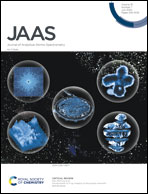Feasibility study on application of laser induced breakdown spectroscopy for detection & identification of failed fuel pins and sodium–water reaction in fast reactors
Abstract
In a fast reactor, during the analysis of the core cover gas, the presence of gaseous fission products, namely, Kr and Xe or the presence of He (in the case of He bonded fuel pins) would indicate the occurrence of fuel pin failure. Similarly, detection of hydrogen (H2) in the surge tank cover gas indicates the possibility of sodium–water reaction. Analysis for the presence of such gases in the cover gas is mandatory towards safety considerations of any fast reactor. This study demonstrates the feasibility of the application of laser induced breakdown spectroscopy (LIBS) for the detection of H2, He, Kr and Xe gases in ultra high purity (UHP) Ar, similar to the cover gas of a fast reactor. The characteristic emission lines at 656.21 nm (Hα), 587.4 nm, 877.67 nm and 881.84 nm are chosen for the quantitative analysis of H2, He, Kr, and Xe, respectively. The calibration curve for all these gases shows a linear fit with a good correlation coefficient. The detection of H2 is found to have interference from the moisture content present in the LIBS sample chamber. The results on identification of the non-overlapping emission lines of these gaseous species, calibration curve, limit of detection, reproducibility and potential application in fast reactors are discussed in this study.



 Please wait while we load your content...
Please wait while we load your content...